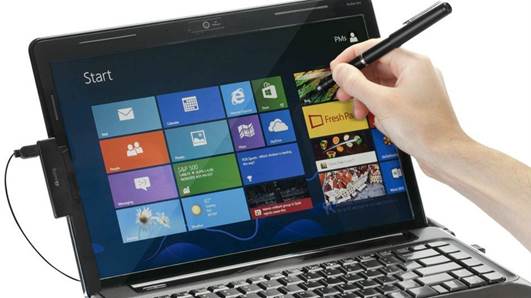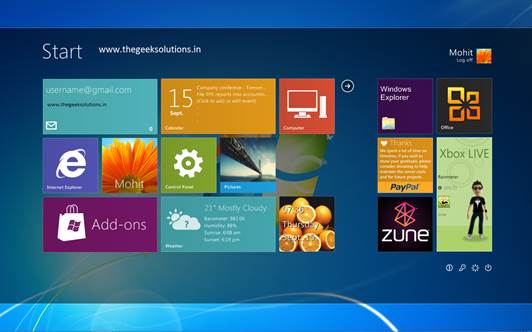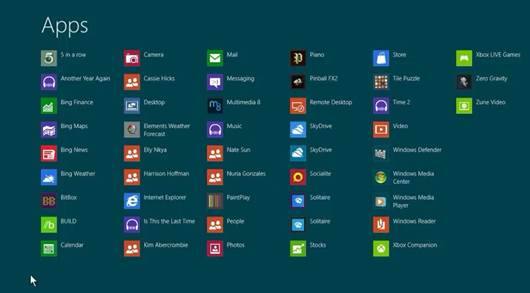Tablets
It's impossible to use Windows 8 and not
feel the influence of tablets on its design. Perhaps that's understandable. A
few months following the release of Windows 7, something unexpected happened to
the computing industry. It was called the iPad, and it did what nettops,
netbooks and even smartphones had failed to do: it altered the computing
industry on a fundamental level.
Suddenly, people didn't want to spend their
money on a desktop system. They wanted a portable, though admittedly less
powerful one. Full-size operating systems and applications gave way to mobile
versions and their low-price, portable apps. Keyboards and mice were replaced
with touch-screens. Microsoft, which had never managed to conquer the portable
world in the first place, was left looking less like a second-stringer and more
like a dinosaur.

It's
impossible to use Windows 8 and not feel the influence of tablets on its design
There's no denying that Windows 7 was great
at what it was designed to do - desktop computing - but its natural interface
features were nascent at best. Between iOS and Android, everyone was getting
excited over tablet operating systems on mobile devices, and Microsoft didn't
have an answer for them. A few Windows 7-based tablets were created, but it was
about as successful as jamming a square peg into a round hole traditionally is.
Windows 7 had high resource requirements and an interface intended to be used
with a mouse and keyboard. It was never going to succeed on tablets.
Indeed, this might even be why Windows 8
was released so quickly. It's certainly why it was redesigned so heavily. As we
alluded earlier in this piece, Windows 8 wasn't aimed at desktop users, but at
tablet users.
From the moment we first saw Windows 8's
Metro Start screen, with its large, tactile animated tiles and sliding screens,
it was quite clear that this version of the OS was aimed squarely (no pun
intended) at the growing and increasingly trendy tablet market.

Windows
8's Metro
Having seen the way the wind was blowing mobile
computing getting more and more prominent while interest in desktop and even
notebook systems beginning to wane - Microsoft decided it didn't want to be
left behind. In effect, it spotted a better-looking basket and decided its eggs
would probably look better in it.
You don't need us to tell you that results
were far from the success Microsoft was hoping for. Despite an aggressive
marketing campaign mainly comprised of smug TV adverts, the Microsoft Surface
tablets barely cut a sliver off the overall market. Almost 50% of all new
tablets run iOS, a further 45% run Android, and the remaining sales are shared
between Windows and other operating systems. Corporate synergy with Windows
Phone 8 has failed to pay off, because no one actually uses Windows Phone 8:
fewer than 5% of all phones worldwide, compared with over 70% using Android and
20% using iOS.
Instead of capturing the lucrative tablet
market, Window 8's shift to a more mobile-centric ethos has had a devastating
effect on its ability to interest desktop users. After all, why buy an
operating system so clearly designed for use with a touch-screen if you don't have
a touch-screen?
This reveals a bigger problem with Windows
8: that on a fundamental level, it has been constructed based on the mistaken
assumption that people want one interface on their phone, tablet and desktop
PC. In attempting to unify all three classes of device, the platform has proven
unable to optimally serve any and desktop has taken the biggest hit as a
result.
This isn't a problem unique to Microsoft.
Apple has similarly wrestled with how to integrate its mobile and desktop
experiences. But Microsoft tried to force the unification before the market was
ready for it, hoping to get an edge over the competition. A brave, though
ultimately misguided goal.
The updates contained in Windows Blue are
unlikely to address this in any meaningful way, however. Short of splitting up
the tablet and desktop experiences entirely, there's no way to optimize Windows
8 for either experience without damaging the other. The cosmetic changes should
help to convince desktop users to come back into the fold, but we wouldn't be
surprised if the interest in Windows 8 as a desktop OS remains stunted long
into the future. Unless the Surface tablet gets an unlikely boost (and there
are suggestions that Windows Blue will add support for a 7-inch tablet, which
would certainly help), it'll leave Microsoft with two underperforming strands.
Performance
Here's the thing about upgrades: they're
supposed to be improvements. When you buy a new piece of software or hardware,
you want it to be better than the piece you left behind. In some ways, this is
the case with Windows 8: systemic improvements allow it to boot and shut down
faster than Windows 7, and certainly it has a lot of new features that will
notionally justify the expense and inconvenience of installing a new operating system.
However, Windows 8 also has a quality that
arguably eclipses those improvements. Tests done by dozens of enthusiasts
consistently show that Windows 8 makes specialist hardware perform more slowly
and less efficiently than Windows 7. Everything from 3D graphics performance to
high-demand processor usage was shown to be slightly worse in Windows 8 than in
its predecessor. For gamers especially, it's an upgrade that isn't an upgrade.

However,
Windows 8 also has a quality that arguably eclipses those improvements
The problem for Microsoft is that gamers
are the leading edge of desktop computing. You can't get the best 3D graphics
on a tablet's screen, and you can't get Core i7 speeds out of an ARM CPU. A
performance increase of even the tiniest percentage would have had gamers
everywhere encouraging their peers to upgrade to Windows 8. Instead, the
opposite is true, and the recommendations are that people stick with Windows 7
if they want to get the best out of their hardware. Not something Windows 8 should
necessarily have to deal with.
So as if Windows 8 didn't have enough to
contend with, it also had computing trend-setters pointing out that it was, if
anything, going to slow your hardware down. Not in all aspects, admittedly -
Windows 8's multimedia performance is conclusively better than Windows 7's -
but people who care about multimedia performance aren't the voice of desktop
evangelism in the way gaming enthusiasts can be.
It's unclear where these problems are
coming from, and until gamers get their hands on Windows Blue, there's no way
to know whether its resource management has improved. For Microsoft's sake,
let's hope it has.